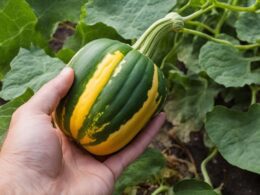If you’ve noticed blue flowers popping up in your garden, you may be dealing with blue flower weeds. While these vibrant blooms can add a touch of color to your outdoor space, they can also be a nuisance and inhibit the growth of nearby plants.
Identifying these blue flower weeds is crucial in effectively managing them. Some common weeds with blue flowers include Asiatic Dayflower, Blue Oxalis, Bush Vetch, Chicory, Forget-me-not, and Henbit, among others.
These weeds can vary in height and flowering times, ranging from low-growing petite plants to taller ones. The blooms can be various shades of blue, from attractive blue-purple flowers to shades of blue mixed with other colors.
It’s important to take appropriate measures to prevent the spread of these blue flower weeds and remove them before they set seed. Failure to do so can lead to extensive infestation and the inhibition of your desired plant growth.
Chemical weed killers may be necessary for effective control of these weeds, especially if they have spread extensively in your lawn or garden. However, it’s essential to follow the instructions carefully and use them responsibly.
By understanding the characteristics and growth habits of these blue flower weeds, you can effectively manage and control them in your garden, ensuring a healthy and thriving outdoor space.
Weeds with Blue Flowers: List and Descriptions
When it comes to identifying weeds with blue flowers, one common example is the Asiatic Dayflower (Commelina communis). This annual flowering plant can be found in gardens, lawns, and waste areas. It features broad leaves and beautiful blue flowers with nectar at the bottom of the stem. The leaves of the Asiatic Dayflower typically measure around 8-13 centimeters in length.
Identifying blue flower weeds in your garden is essential for effective weed management. By recognizing the characteristics of these weeds, you can employ targeted control methods to prevent their spread and protect your other plants.
Continued in Section 3…
Conclusion
Weeds with blue flowers can add a touch of beauty to your garden, but they can also become a nuisance. To effectively manage these blue flower weeds, it is crucial to correctly identify them. Some of these weeds have the potential to inhibit the growth of nearby plants and spread rapidly.
Preventing the spread of these weeds is essential in order to avoid further infestation. Removing them before they set seed is a key step in managing their growth. In cases where these weeds have spread extensively, chemical weed killers may be necessary for effective control.
Regular maintenance practices such as deadheading, hand-pulling, and mowing can go a long way in preventing the spread of blue flower weeds and maintaining a healthy garden. Remember to consult reliable references to positively identify any plants before considering them for consumption.
By understanding the characteristics and growth habits of these blue flower weeds, you can take appropriate measures to manage and control them in your garden, ensuring the beauty of your flowers and the health of your other plants.
Are Weeds With Red Stems Harmful to Your Garden Like Weeds With Blue Flowers?
Identifying weed with red stem is important for gardeners as it helps in distinguishing harmful weeds from harmless ones. While weeds with blue flowers may be concerning, those with red stems can also pose a threat to your garden. Proper identification and timely removal are crucial for maintaining a healthy garden.









